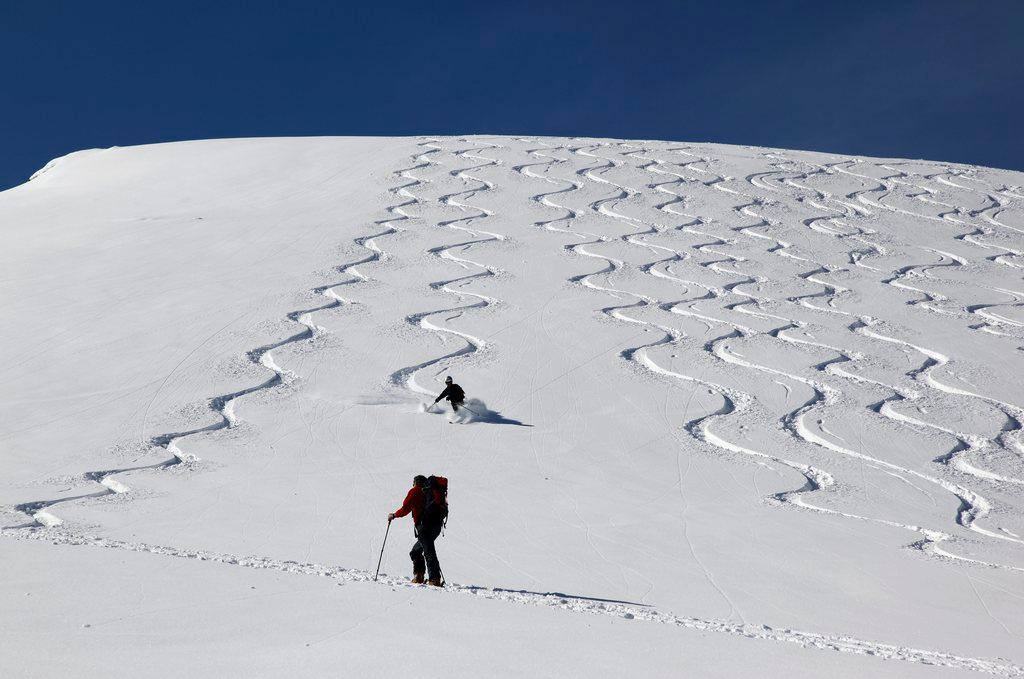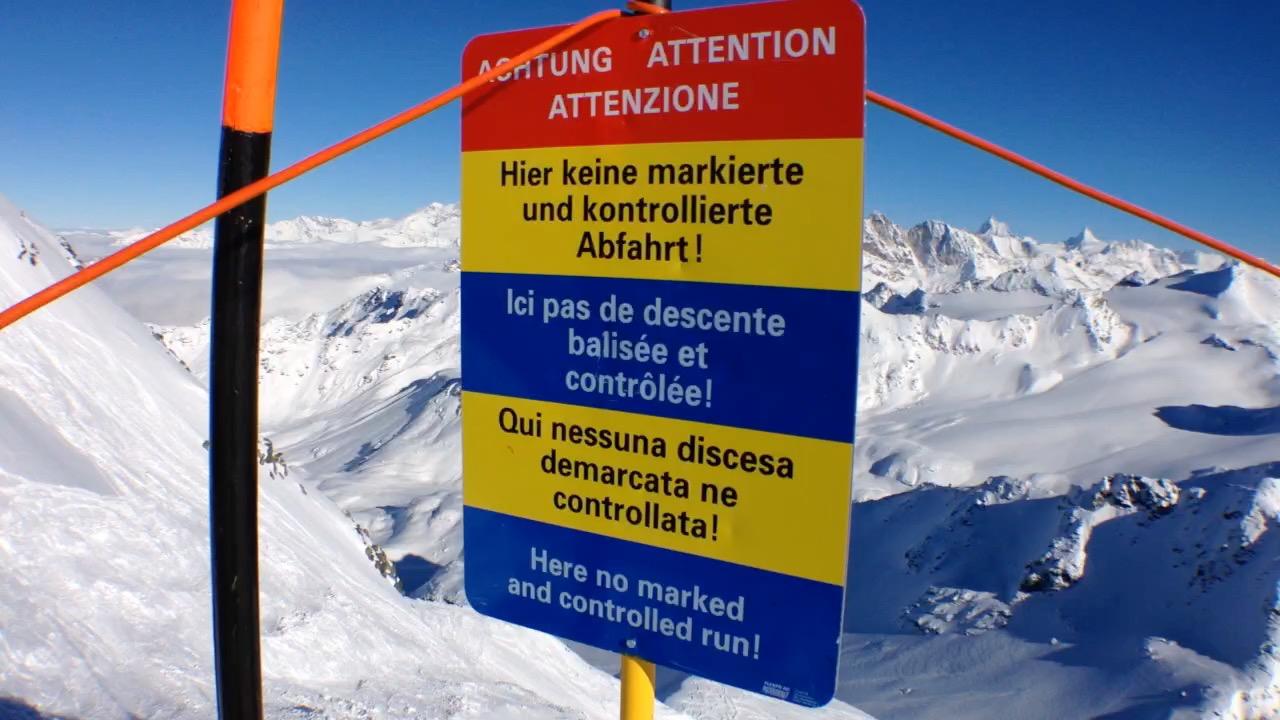Despite headlines, avalanche death toll falls

Are backcountry skiers in Switzerland – seduced by the mountains and virgin powder – taking more risks than in the past? Or are better ski gear, weather forecasts and education for novices keeping the annual avalanche death toll down?
Low clouds and heavy snow are making Martin’s search difficult. Bent forward and breathing hard, he struggles up the slope with his bright green avalanche beacon outstretched.
The transceiver’s regular beep and digital arrow are telling him to keep going right, but he’s not sure. He spins around, hesitates, and then doubles back. After two or three minutes the noise gets steadily more frenetic.
“It’s here,” he shouts. In a flash he assembles his aluminium probe and starts stabbing the snow in a spiral movement. Seconds later the tip of his probe strikes something hard.
“Well done, you’ve found it,” shouts a Verbier guide watching nearby. The ‘It’ in this case was not a victim but an electronic emitter buried under deep snow at the Verbier DVA Park.

More
Verbier avalanche training
A recent spate of deaths among backcountry skiers has hit the Swiss headlines, but this year’s spike in avalanche fatalities is misleading, according to statistics compiled by outdoor groups. Along with the rising popularity of the sport has come a boost in education efforts, a key factor credited with a reduction over the past eight decades in the average number of people who die each year in avalanches.
Fortunately for Martin this was just an exercise – a chance for the youngster to practise using the new kit his father had bought.
“Martin is almost 12 years old and a good skier. When he’s 15 or 16 he’ll want to go off skiing with friends and I’ll be worried sick,” said his dad, Christian Struchen, who lives in Neuchâtel. “I realised the best way not to be afraid in the future was to educate him.”
The resort of Verbier in western Switzerland has been offering visitors free avalanche prevention training on the slopes for several seasons, and the short hour-long lessons have grown in popularity, said local guide Yann Décaillet.
“We saw that even for an 11-year-old who has never done it before, the searching is quite easy. But that’s just a short part of the rescue. We start by searching, then probing and then digging. The most important and toughest part is the digging. To dig out someone who is one metre deep you need to clear 1.5 tonnes of snow,” he added.
One day earlier, just 20 km away as the crow flies in the region of the Great St Bernard Pass near the Swiss-Italian border, five Italian skiers on a ski tour had to be dug out after being swept away by an avalanche; four of them – two men and two women – later died in hospital.
This accident brings the total number of avalanche deaths in Switzerland this season to 25. In early February a dozen people died in only three days in February after heavy snowfalls and despite warnings that it was dangerous to ski off-piste, the European term for skiing in the backcountry, beyond the area that’s routinely maintained or patrolled for safety by a ski area.
The dramatic death toll has hit the Swiss headlines. But this year’s spike in avalanche fatalities is misleading, as statistics appear to tell a different story.
While the number of ski tourers and freeriders has risen in recent years – according to the Swiss Alpine Club (SAC)External link ski tourers have quadrupled over the past 30 years to 240,000 – the number of avalanche accidents has been sliding steadily downwards.
Over the past 20 years an average of 22 people have died annually in avalanches while skiing or snowboarding, down from 25 over the past 77 years.
Professional freerider Dominique PerretExternal link told Le Matin Dimanche newspaper that a prime reason for the rising numbers of people skiing off-piste is not because it’s a “fashionable” trend but because there are low-cost air carriers making the sport more affordable. “London to Mont Fort is possible in six hours,” Perret was quoted as saying. “Lots of amateurs now come from non-alpine countries.”
In the distance the Mont Fort cable car disappears into the clouds, carrying skiers from around the globe, with their fat skis and airbags, who dream of couloirs and deserted powder bowls.
From the top at 3,329 metres they have spectacular views and almost instant access to a wide variety of off-piste skiing.

More
The back side of Mont Fort
The recent off-piste trends and fatalities have prompted some criticism of younger generations of skiers who are new to the burgeoning sport and may be tempted to put their faith in technology ahead of old-fashioned experience.
Swiss avalanche expert and former guide Werner Munter blamed what he calls the “selfie-generation” mentality where people want to be the first to leave their tracks on virgin powder fields.
“There is a crass lack of knowledge of avalanches which pushes skiers to take too many risks,” the 73-year-old told Le Matin newspaper.
The guide believes avalanche beacons and airbagsExternal link give people a false sense of security. And with the latest wide, big mountain freeride skis, average-level skiers can now go down the kinds of steep slopes that were previously reserved for top technical skiers, he added.
Perret, however, defended the young generation: “The new generation is generally well equipped and rather responsible. The figures tend to show that the 35–55-year-olds are more at risk than the 18–35-year-olds.”
Décaillet said in general he didn’t think people were more reckless.
“I think people are more trained and realise that they can’t go off piste just any old time. I have the feeling they are a little more careful and know their equipment a bit better,” he added.

More
Setting off an avalanche – on purpose
The skier tourers who died at the Great St Bernard Pass, and others who perished on the Piz Vilan mountain in canton Graubünden in February, were reportedly experienced and went out when the avalanche danger was at levels two and three, respectively, on a scale of five.
Ueli Mosimann, a member of the SAC mountain safety working group, rejects the idea that ski tourers are more irresponsible nowadays – quite the contrary in fact. An article he wrote for the SAC “Die Alpen” review last year about the dangers of high-mountain sports showed a reduction in the deadly risks of ski touring: down from 11 fatalities per year per 100,000 people practising the sport between 1984 and 1993 to four deaths for the 2004-2013 period.
He stresses that backcountry skiing is practised differently by ski tourers and freeriders.
“Some people take lifts to the top without any preparation and without analysing the slope and launch themselves down the snowfield,” he declared.
He felt ski touring and mountaineering had become a lot safer due to better training and information, safer routes, equipment like avalanche beacons and smartphones and faster rescue responses, not forgetting avalanche forecast bulletins.
In Switzerland the Institute for Snow and Avalanche ResearchExternal link (SLF) produces a national avalanche bulletin twice a day, obtained from 170 automatic measuring stations, 210 observers throughout the Swiss Alps, snowpack models and other weather data. Recently the bulletin has been optimized for the internet alongside a ‘White Risk’ smartphone appExternal link.
Despite this progress, more precise avalanche maps are something guides still dream about.
“To do their bulletin they have scientists at Davos, observers and guides, but to do it by valley is not possible. At least not for now. And you can’t do more bulletins in one day. Already two is fantastic. But they are by region. [On the day of the avalanche at Grand St Bernard] the city of Sion in the Rhône Valley had the same danger as the top of Mont Fort. So you see that it’s not always possible to be that accurate,” said Décaillet.
Avalanche survival
Avalanches in Switzerland have killed 227 people in the past ten years, 40% of them in canton Valais. So far this season there have been 25 deaths.
According to statistics, only about one of every two people who are completely buried by an avalanche (head in the snow) manage to survive. The most common cause of death is asphyxiation because the snow usually cuts off all but a small pocket of air. The chances of a person surviving a complete burial therefore reduce significantly after just 15 minutes. That’s why it’s so important for avalanche rescuers to be trained to work quickly.
An avalanche that doesn’t completely bury someone still poses significant risks: at least one in seven fatalities occurs as a consequence of serious injury.
Ninety per cent of victims set off their own avalanches. Most are caused by men (75%), aged 20-30 in non-guided groups of two to four people. They occur when the official danger levels are three (57%) and two (31%) on a scale of five.
SLF research from 2013 showed that improved prevention methods and faster and more efficient rescues had reduced the median burial time of fully buried people to 30 minutes.
Institute for Snow and Avalanche ResearchExternal link (SLF)

In compliance with the JTI standards
More: SWI swissinfo.ch certified by the Journalism Trust Initiative











You can find an overview of ongoing debates with our journalists here . Please join us!
If you want to start a conversation about a topic raised in this article or want to report factual errors, email us at english@swissinfo.ch.